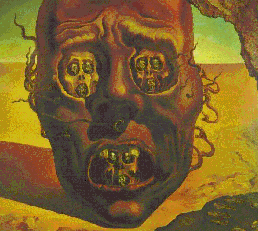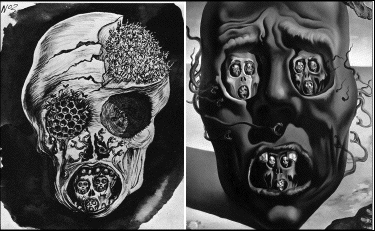 |
 |
| In Dali's Visage of War (1940) note the eyes and mouth each contain a face, whose eyes and mouth each contain a face, many of whose eyes and mouth each contain a face, an obvious, if gruesome, example of fractals in art. | ||
| Dali thought of the Spanish Civil War, in 1940 a source of frightening images to him. Descharnes described the painting as having "eyes filled with infinite death," referring to the recursive effect set in motion by self-similarity. | ||
| Interestingly, a preliminary study (left) of this picture had a face within only one face within the mouth of the largest face. | ||
| Although the study certainly is disturbing, note that Dali had not yet established the self-similarity of the painting. | ||
| Perhaps Dali decided the infinite horrors of war were better depicted in a bounded canvas through self-similarity, though most certainly he had not been exposed to this as a mathematical concept. | ||
| In the painting, he captured the infinite horror of war by through the implied infinite regress of self-similarity. | ||
| ||
| Click the pictures for magnifications in new windows. | ||
| Note also the handprint in the lower right of the painting. This is Dali's handprint; this is the only painting signed with his handprint, a testimony to the power this painting had for Dali. |